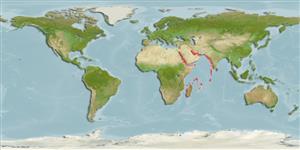Common names from other countries
Environment: milieu / climate zone / depth range / distribution range
Sinh thái học
; Mức độ sâu 0 - 65 m (Ref. 106819). Tropical
Western Indian Ocean: From Pakistan westwards to the Arabian Gulf extending to the east African coast to South Africa and to Madagascar and Mauritius. Introduced in the Mediterranean through the Suez Canal and established up to the northern Tyrrhenian Sea.
Length at first maturity / Bộ gần gũi / Khối lượng (Trọng lượng) / Age
Maturity: Lm 7.4 range ? - ? cm Max length : 16.2 cm CW con đực/không giới tính; (Ref. 115276); 16.2 cm CW (female)
Lives mainly in coastal waters in seagrass meadows and along mangroves (Ref. 115276), and intertidal mudflats (Ref. 128960). Found under rocks and in rock pools, on sandy or muddy substrate (Ref. 111207). Larger biomass is seen between depths of 2 to 15 m. Small juveniles are found in very shallow waters (less than 1 m); females occupy deep-water zones during spawning (Ref. 115276). Opportunistic predator, primarily a carnivore preying on a variety of benthic animals and less marine plants and seagrass (Ref. 108412). Prolific predators of bivalves. Some suggested that they're opportunistic omnivores or detritivores, feeding on carrion, especially on fishing-discards. Efficient night time forager, using a characteristic zigzag search pattern to locate prey (Ref. 115276).
Safaie, M., J. Pazooki, B. Kiabi and M.R. Shokri. 2013. (Ref. 107016)
IUCN Red List Status (Ref. 130435)
CITES status (Ref. 108899)
Not Evaluated
Not Evaluated
Threat to humans
Harmless
Human uses
| FishSource |
Các công cụ
Các nguồn internet
Estimates based on models
Thích nghi nhanh
Chiêù cao, thời gian nhân đôi của chủng quần tối thiểu là dưới 15 tháng (K=1.6-1.7).
